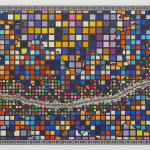



Lordy Rodriguez Filipino, b. 1976
Selma to Montgomery, 2020
ink on paper
26 x 52 in
66 x 132.1 cm
66 x 132.1 cm
Further images
March 7th, 2020 marked the 55th anniversary of “Bloody Sunday,” the first of three nonviolent protest marches in Alabama during the civil rights movement of the 1960s. Here, Lordy Rodriguez...
March 7th, 2020 marked the 55th anniversary of “Bloody Sunday,” the first of three nonviolent protest marches in Alabama during the civil rights movement of the 1960s.
Here, Lordy Rodriguez reproduces this pivotal 54-mile march from Selma, Alabama to the state capital of Montgomery. Rodriguez uses color and scale to reflect the tension and resistance that marked the critical movement. Scale, as seen in three sections of grids that surround and contract as they move closer to the march route, is used to illustrate the compounding pressure protestors may have felt during the marches. The use of complimentary colors in these same sections (purple/yellow, blue/orange and red/green) act as a metaphor for opposition - a theme that saturated the nation at the time.
The circular mark in the middle left of the work highlights the location of the Edmund Pettus Bridge, ironically named after Edmund Pettus, a known Ku Klux Klan grand master, which was the site of the “Bloody Sunday” attacks against unarmed protesters. The violence against these protesters sparked a national outcry and ultimately contributed to the enactment of the landmark Voting Rights Act of 1965.
Here, Lordy Rodriguez reproduces this pivotal 54-mile march from Selma, Alabama to the state capital of Montgomery. Rodriguez uses color and scale to reflect the tension and resistance that marked the critical movement. Scale, as seen in three sections of grids that surround and contract as they move closer to the march route, is used to illustrate the compounding pressure protestors may have felt during the marches. The use of complimentary colors in these same sections (purple/yellow, blue/orange and red/green) act as a metaphor for opposition - a theme that saturated the nation at the time.
The circular mark in the middle left of the work highlights the location of the Edmund Pettus Bridge, ironically named after Edmund Pettus, a known Ku Klux Klan grand master, which was the site of the “Bloody Sunday” attacks against unarmed protesters. The violence against these protesters sparked a national outcry and ultimately contributed to the enactment of the landmark Voting Rights Act of 1965.
Your shopping bag
This purchase may be subject to local rates of import, sales and use taxes for which the purchaser is 100% liable.
No items found
Close
Your Favorites
Create a list of works then send us an inquiry.
No items found



